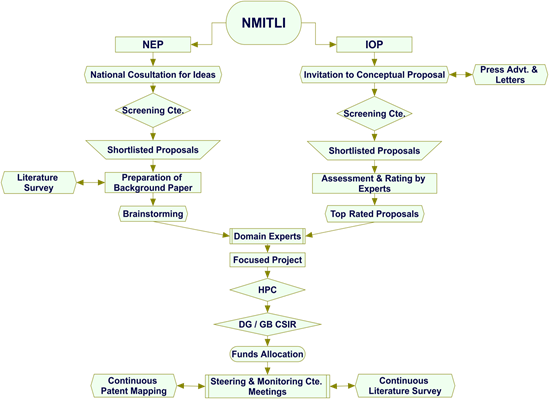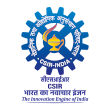Management Structure
Management Structure
Management Structure
A dynamic and vibrant management system has been put in place to manage the Program and projects. At the hub of the management structure is the Mission Directorate, which manages the entire program. It interacts with PIs and the Monitoring Committee on one hand and the High Powered Committee, DG, CSIR and Governing Body of CSIR on the other.

Operational changes introduced
While approving the NMITLI scheme in March 2003, the CCEA had authorized the Governing Body of CSIR to effect operational changes (in the operation of the scheme) based on the exigencies of functioning in a dynamic global setting, within the overall financial outlays. Accordingly, the Governing Body of CSIR has introduced operational changes in the operation of the scheme which were felt necessary. These include: (i) Innovative capacity as criteria for NMITLI support to start-up companies; (ii) Rescheduling of loan repayment in select areas; and (iii) Financial support in the intermittent period. Brief details of these are presented below:
1. Innovative capacity as criteria for NMITLI support to startup companies
In case NMITLI restricts itself to consider only (as it does presently) the financial soundness of the company for extending financial support, it would end up supporting those set ups who are already on a strong financial footing. This situation is contrary to scenario world over and would deprive the startup companies bubbling with new and novel ideas, with out-of-box thinking and approach. Further, the risk taking capacities of these companies are much higher and they are eager to embark on newer frontiers in the realm of technology and business. Taking a liberal view on this issue in the light of cherished objectives of NMITLI program, GB, CSIR has decided to support such companies whose innovation capacity are high, utilizing up to 25% of NMITLI funds. To mentor such companies, in addition to existing monitoring mechanism, NMITLI would involve a financial institution like ICICI and one or two Technical Experts for necessary hand holding and regular guidance.
2. Rescheduling of loan repayment in select areas
The financial support under NMITLI is in the form of grant-in-aid to the institutional partners in public domain and as soft loan with 3% interest to the private sector industrial partners. The repayment of the loan component as well as interest by the industry partners is in 10 yearly installments which commences within six months of the completion of the project or within 18 months of release of last installment of loan whichever is earlier. This procedure is being followed where loan repayment has become due.
While operating the NMITLI Scheme for last few years, some difficulties in the procedure followed have been experienced. These are as follows:
- Depending upon the progress of the project, if additional work is required to be undertaken in order to fine tune / validate the technology product concept, extension of the project is provided based on Monitoring Committee recommendations. In such cases a situation arises where industrial partner has to pay back loan installments while the project is still under execution. It needs to be corrected, and a provision is required to be introduced so that loan repayment starts only after completion of the project(s).
- Some projects in the scheme fall under the area of Drugs & Pharmaceuticals. The projects normally start either at ‘Proof of Concept’ stage or at the stage of pre-clinical research. Leads obtained from the above projects have to essentially go through Investigational New Drugs (IND) application and regulatory process (Phase-I, II & III clinical trials in human subjects) before becoming a commercializable product. In the present situation, loan given to industry for projects at the stage of proof of concept/pre-clinical has to be returned while industry is conducting clinical trials on the formulation. Thus, industry needs to invest on two fronts i.e. for clinical trials and for loan repayment. Many a times, NMITLI funds these projects for conducting clinical trials (phase-II projects) also. This creates a situation where on one hand industry is receiving funds for clinical trials and on the other refunding the installment of previous loan.
3. Financial support in the intermittent period
The projects which move from ‘proof of concept’ stage to the next stage require development of a new project. Usually development of such projects and their approvals take considerable time. There was no provision for maintaining desired R&D activities during the intermittent period. Therefore, in order to maintain the pace of desired R&D activities and provide continuity, CSIR decided to provide financial support in the intermittent period to those projects which were recommended to move from one phase to other.
Implementation of NMITLI
Types of Projects
Keeping in view the objectives, NMITLI evolves both ‘push’ and ‘pull’ type of projects, which are appropriately named as (i) Nationally Evolved Projects (NEP); and (ii) Industry Originated Projects (IOP). The selection and development of projects follow a rigorous process with several stages of filtering through expert interventions. The best brains in the country are then entrusted with the responsibility of developing focused projects through intensive consultations and discussions with stake holders. The projects thus developed are considered and reviewed by a specially constituted High Powered Committee (HPC), comprising experts from diverse fields including financial institutions. The recommendation(s) of HPC are finally considered by CSIR Governing Body for necessary approval or otherwise of the project(s).
Flow diagrams for Nationally Evolved Projects (NEP) and Industry Originated Projects (IOP) are given below:
Stringent Selection Process


 Pensioners Corner
Pensioners Corner Screen Reader Access
Screen Reader Access Skip to main content
Skip to main content

























